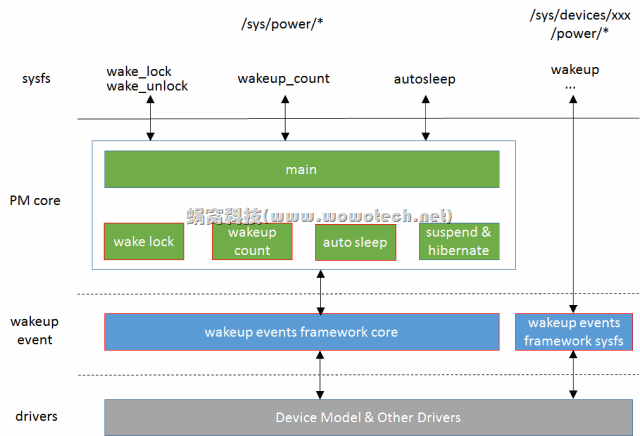Linux電源管理_Wakeup events framework--(二)
1. 前言
本文繼續“Linux電源管理(6)_Generic PM之Suspend功能”中有關suspend同步以及PM wakeup的話題。這個話題,是近幾年Linux kernel最具爭議的話題之一,在國外Linux開發論壇,經常可以看到圍繞該話題的辯論。辯論的時間跨度和空間跨度可以持續很長,且無法達成一致。
wakeup events framework是這個話題的一個臨時性的解決方案,包括wake lock、wakeup count、autosleep等機制。它們就是本文的話題。
2. wakeup events framework要解決的問題
我們知道,系統處於suspend狀態,可通過wakeup events喚醒。具體的wakeup events可以是按鍵按下,可以是充電器插入,等等。但是,如果在suspend的過程中,產生了wakeup events,怎麼辦?答案很肯定,"wakeup"系統。由於此時系統沒有真正suspend,所以這的"wakeup"是個假動作,實際上只是終止suspend。
但由於系統在suspend的過程中,會進行process freeze、 device suspend等操作,而這些操作可能導致核心或使用者空間程式不能及時獲取wakeup events,從而使系統不能正確wakeup,這就是wakeup events framework要解決的問題:system suspend和system wakeup events之間的同步問題。
3. wakeup events framework的功能總結
仔細推敲一下,上面所講的同步問題包括兩種情況:
情況1:核心空間的同步
wakeup events產生後,通常是以中斷的形式通知device driver。driver會處理events,處理的過程中,系統不能suspend。
注1:同步問題只存在於中斷開啟的情況,因為若中斷關閉,就不會產生wakeup events,也就不存在同步的概念。
情況2:使用者空間的同步
一般情況下,driver對wakeup events處理後,會交給使用者空間程式繼續處理,處理的過程,也不允許suspend。這又可以分為兩種情況:
1)進行後續處理的使用者程序,根本沒有機會被排程,即該wakeup events無法上報到使用者空間。
2)進行後續處理的使用者程序被排程,處理的過程中(以及處理結束後,決定終止suspend操作),系統不能suspend。
因此,wakeup events framework就包括3大功能:
解決核心空間同步問題(framework的核心功能);
解決使用者空間同步問題的情景1(wakeup count功能);
解決使用者空間同步問題的情景2(wake lock功能) 。
注2:
使用者空間同步的兩種情況,咋一看,非常合乎情理,kernel你得好好處理!但事實上,該同步問題牽涉到了另外一個比較有爭議的話題:日常的電源管理機制。是否要基於suspend實現?系統何時進入低功耗狀態,應該由誰決定?kernel還是使用者空間程式?
這最終會決定是否存在用空間同步問題。但是,在當前這個時間點,對這個話題,Linux kernel developers和Android developers持相反的觀點。這也造成了wakeup events framework在實現上的撕裂。Kernel的本意是不願處理使用者空間同步問題的,但為了相容Android平臺,不得不增加相關的功能(Wakeup count和Wake lock)。
蝸蝸會在下一篇文章和大家探討該話題,本文就先focus在wakeup events framework上。
4. wakeup events framework architecture
下面圖片描述了wakeup events framework的architecture:
圖片中紅色邊框的block是wakeup events相關的block:
1)wakeup events framework core,在drivers/base/power/wakeup.c中實現,提供了wakeup events framework的核心功能,包括:
抽象wakeup source和wakeup event的概念;
向各個device driver提供wakeup source的註冊、使能等介面;
向各個device driver提供wakeup event的上報、停止等介面;
向上層的PM core(包括wakeup count、auto sleep、suspend、hibernate等模組)提供wakeup event的查詢介面,以判斷是否可以suspend、是否需要終止正在進行的suspend。
2)wakeup events framework sysfs,將裝置的wakeup資訊,以sysfs的形式提供到使用者空間,供使用者空間程式查詢、配置。在drivers/base/power/sysfs.c中實現。
3)wake lock/unlock,為了相容Android舊的wakeup lock機制而留下的一個後門,擴充套件wakeup events framework的功能,允許使用者空間程式報告/停止wakeup events。換句話說,該後門允許使用者空間的任一程式決定系統是否可以休眠。
4)wakeup count,基於wakeup events framework,解決使用者空間同步的問題。
5)auto sleep,允許系統在沒有活動時(即一段時間內,沒有產生wakeup event),自動休眠。
注3:在Linux kernel看來,power是系統的核心資源,不應開放給使用者程式隨意訪問(wake lock機制違背了這個原則)。而在執行時的電源管理過程中,系統何時進入低功耗狀態,也不是使用者空間程式能決定的(auto sleep中槍了)。因此,kernel對上述功能的支援,非常的不樂意,我們可以從kernel/power/main.c中sysfs attribute檔案窺見一斑(只要定義了PM_SLEEP,就一定支援wakeup count功能,但autosleep和wake lock功能,由另外的巨集定義控制):
1: static struct attribute * g[] = {
2: &state_attr.attr,
3: #ifdef CONFIG_PM_TRACE
4: &pm_trace_attr.attr,
5: &pm_trace_dev_match_attr.attr,
6: #endif
7: #ifdef CONFIG_PM_SLEEP
8: &pm_async_attr.attr,
9: &wakeup_count_attr.attr,
10: #ifdef CONFIG_PM_AUTOSLEEP
11: &autosleep_attr.attr,
12: #endif
13: #ifdef CONFIG_PM_WAKELOCKS
14: &wake_lock_attr.attr,
15: &wake_unlock_attr.attr,
16: #endif
17: #ifdef CONFIG_PM_DEBUG
18: &pm_test_attr.attr,
19: #endif
20: #ifdef CONFIG_PM_SLEEP_DEBUG
21: &pm_print_times_attr.attr,
22: #endif
23: #endif
24: #ifdef CONFIG_FREEZER
25: &pm_freeze_timeout_attr.attr,
26: #endif
27: NULL,
28: };
5. 程式碼分析
5.1 wakeup source和wakeup event
在kernel中,可以喚醒系統的只有裝置(struct device),但並不是每個裝置都具備喚醒功能,那些具有喚醒功能的裝置稱作wakeup source。是時候回到這篇文章中了(Linux裝置模型(5)_device和device driver),在那裡,介紹struct device結構時,涉及到一個struct dev_pm_info型別的power變數,蝸蝸說留待後面的專題講解。我們再回憶一下struct device結構:
1: struct device {
2: ...
3: struct dev_pm_info power;
4: ...
5: };
該結構中有一個power變數,儲存了和wakeup event相關的資訊,讓我們接著看一下struct dev_pm_info資料結構(只保留和本文有關的內容):
1: struct dev_pm_info {
2: ...
3: unsigned int can_wakeup:1;
4: ...
5: #ifdef CONFIG_PM_SLEEP
6: ...
7: struct wakeup_source *wakeup;
8: ...
9: #else
10: unsigned int should_wakeup:1;
11: #endif
12: };
can_wakeup,標識本裝置是否具有喚醒能力。只有具備喚醒能力的裝置,才會在sysfs中有一個power目錄,用於提供所有的wakeup資訊,這些資訊是以struct wakeup_source的形式組織起來的。也就是上面wakeup指標。具體有哪些資訊呢?讓我們看看struct wakeup_source的定義。
1: /* include\linux\pm_wakeup.h */
2: struct wakeup_source {
3: const char *name;
4: struct list_head entry;
5: spinlock_t lock;
6: struct timer_list timer;
7: unsigned long timer_expires;
8: ktime_t total_time;
9: ktime_t max_time;
10: ktime_t last_time;
11: ktime_t start_prevent_time;
12: ktime_t prevent_sleep_time;
13: unsigned long event_count;
14: unsigned long active_count;
15: unsigned long relax_count;
16: unsigned long expire_count;
17: unsigned long wakeup_count;
18: bool active:1;
19: bool autosleep_enabled:1;
20: };
因此,一個wakeup source代表了一個具有喚醒能力的裝置,也稱該裝置為一個wakeup source。該結構中各個欄位的意義如下:
name,該wakeup source的名稱,一般為對應的device name(有個例外,就是wakelock);
entery,用於將所有的wakeup source掛在一個連結串列中;
timer、timer_expires,一個wakeup source產生了wakeup event,稱作wakeup source activate,wakeup event處理完畢後(不再需要系統為此保持active),稱作deactivate。activate和deactivate的操作可以由driver親自設定,也可以在activate時,指定一個timeout時間,時間到達後,由wakeup events framework自動將其設定為deactivate狀態。這裡的timer以及expires時間,就是用來實現該功能;
total_time,該wakeup source處於activate狀態的總時間(可以指示該wakeup source對應的裝置的繁忙程度、耗電等級);
max_time,該wakeup source持續處於activate狀態的最大時間(越長越不合理);
last_time,該wakeup source上次active的開始時間;
start_prevent_time,該wakeup source開始阻止系統自動睡眠(auto sleep)的時間點;
prevent_sleep_time,該wakeup source阻止系統自動睡眠的總時間;
event_count,wakeup source上報的event個數;
active_count,wakeup source activate的次數;
relax_count, wakeup source deactivate的次數;
expire_count,wakeup source timeout到達的次數;
wakeup_count,wakeup source終止suspend過程的次數;
active,wakeup source的activate狀態;
autosleep_enabled,記錄系統auto sleep的使能狀態(每個wakeup source都重複記錄這樣一個狀態,這種設計真實不敢恭維!)。
wakeup source代表一個具有喚醒能力的裝置,該裝置產生的可以喚醒系統的事件,就稱作wakeup event。當wakeup source產生wakeup event時,需要將wakeup source切換為activate狀態;當wakeup event處理完畢後,要切換為deactivate狀態。因此,我們再來理解一下幾個wakeup source比較混淆的變數:event_count, active_count和wakeup_count:
event_count,wakeup source產生的wakeup event的個數;
active_count,產生wakeup event時,wakeup source需要切換到activate狀態。但並不是每次都要切換,因此有可能已經處於activate狀態了。因此active_count可能小於event_count,換句話說,很有可能在前一個wakeup event沒被處理完時,又產生了一個。這從一定程度上反映了wakeup source所代表的裝置的繁忙程度;
wakeup_count,wakeup source在suspend過程中產生wakeup event的話,就會終止suspend過程,該變數記錄了wakeup source終止suspend過程的次數(如果發現系統總是suspend失敗,檢查一下各個wakeup source的該變數,就可以知道問題出在誰身上了)。
5.2 幾個counters
在drivers\base\power\wakeup.c中,有幾個比較重要的計數器,是wakeup events framework的實現基礎,包括:
1)registered wakeup events和saved_count
記錄了系統執行以來產生的所有wakeup event的個數,在wakeup source上報event時加1。
這個counter對解決使用者空間同步問題很有幫助,因為一般情況下(無論是使用者程式主動suspend,還是auto sleep),由專門的程序(或執行緒)觸發suspend。當這個程序判斷系統滿足suspend條件,決定suspend時,會記錄一個counter值(saved_count)。在後面suspend的過程中,如果系統發現counter有變,則說明系統產生了新的wakeup event,這樣就可以終止suspend。
該功能即是wakeup count功能,會在後面更詳細的說明。
2)wakeup events in progress
記錄正在處理的event個數。
當wakeup source產生wakeup event時,會通過wakeup events framework提供的介面將wakeup source設定為activate狀態。當該event處理結束後,設定為deactivate狀態。activate到deactivate的區間,表示該event正在被處理。
當系統中有任何正在被處理的wakeup event時,則不允許suspend。如果suspend正在進行,則要終止。
思考一個問題:registered wakeup events在什麼時候增加?答案是在wakeup events in progress減小時,因為已經完整的處理完一個event了,可以記錄在案了。
基於這種特性,kernel將它倆合併成一個32位的整型數,以原子操作的形式,一起更新。這種設計巧妙的讓人叫絕,值得我們學習。具體如下:
1: /*
2: * Combined counters of registered wakeup events and wakeup events in progress.
3: * They need to be modified together atomically, so it's better to use one
4: * atomic variable to hold them both.
5: */
6: static atomic_t combined_event_count = ATOMIC_INIT(0);
7:
8: #define IN_PROGRESS_BITS (sizeof(int) * 4)
9: #define MAX_IN_PROGRESS ((1 << IN_PROGRESS_BITS) - 1)
10:
11: static void split_counters(unsigned int *cnt, unsigned int *inpr)
12: {
13: unsigned int comb = atomic_read(&combined_event_count);
14:
15: *cnt = (comb >> IN_PROGRESS_BITS);
16: *inpr = comb & MAX_IN_PROGRESS;
17: }
定義和讀取。
1: cec = atomic_add_return(MAX_IN_PROGRESS, &combined_event_count);
wakeup events in progress減1,registered wakeup events加1,這個語句簡直是美輪美奐,讀者可以仔細品味一下,絕對比看xxx片還過癮,哈哈。
1: cec = atomic_inc_return(&combined_event_count);
wakeup events in progress加1。
5.3 wakeup events framework的核心功能
wakeup events framework的核心功能體現在它向底層的裝置驅動所提供的用於上報wakeup event的介面,這些介面根據操作物件可分為兩類,具體如下。
型別一(操作物件為wakeup source,編寫裝置驅動時,一般不會直接使用):
1: /* include/linux/pm_wakeup.h */
2: extern void __pm_stay_awake(struct wakeup_source *ws);
3: extern void __pm_relax(struct wakeup_source *ws);
4: extern void __pm_wakeup_event(struct wakeup_source *ws, unsigned int msec);
__pm_stay_awake,通知PM core,ws產生了wakeup event,且正在處理,因此不允許系統suspend(stay awake);
__pm_relax,通知PM core,ws沒有正在處理的wakeup event,允許系統suspend(relax);
__pm_wakeup_event,為上邊兩個介面的功能組合,通知PM core,ws產生了wakeup event,會在msec毫秒內處理結束(wakeup events framework自動relax)。
注4:__pm_stay_awake和__pm_relax應成對呼叫。
注5:上面3個介面,均可以在中斷上下文呼叫。
型別二(操作物件為device,為裝置驅動的常用介面):
1: /* include/linux/pm_wakeup.h */
2: extern int device_wakeup_enable(struct device *dev);
3: extern int device_wakeup_disable(struct device *dev);
4: extern void device_set_wakeup_capable(struct device *dev, bool capable);
5: extern int device_init_wakeup(struct device *dev, bool val);
6: extern int device_set_wakeup_enable(struct device *dev, bool enable);
7: extern void pm_stay_awake(struct device *dev);
8: extern void pm_relax(struct device *dev);
9: extern void pm_wakeup_event(struct device *dev, unsigned int msec);
device_set_wakeup_capable,設定dev的can_wakeup標誌(enable或disable,可參考5.1小節),並增加或移除該裝置在sysfs相關的power檔案;
device_wakeup_enable/device_wakeup_disable/device_set_wakeup_enable,對於can_wakeup的裝置,使能或者禁止wakeup功能。主要是對struct wakeup_source結構的相關操作;
device_init_wakeup,設定dev的can_wakeup標誌,若是enable,同時呼叫device_wakeup_enable使能wakeup功能;
pm_stay_awake、pm_relax、pm_wakeup_event,直接呼叫上面的wakeup source操作介面,操作device的struct wakeup_source變數,處理wakeup events。
5.3.1 device_set_wakeup_capable
該介面位於在drivers/base/power/wakeup.c中,程式碼如下:
1: void device_set_wakeup_capable(struct device *dev, bool capable)
2: {
3: if (!!dev->power.can_wakeup == !!capa

